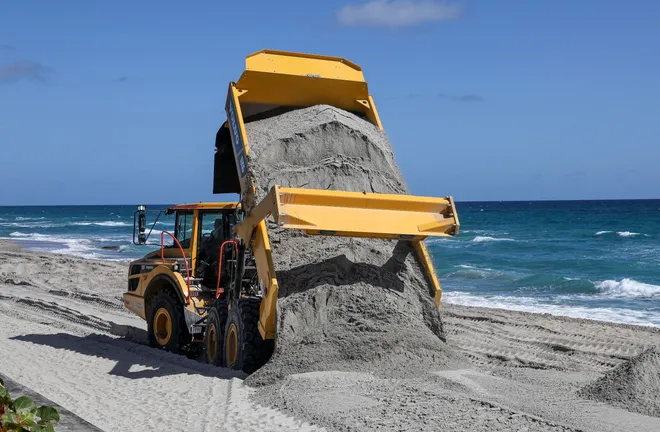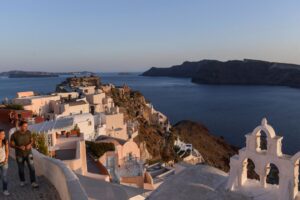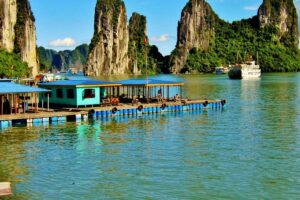The town’s beaches will continue to accumulate sand in the coming years and remain in good condition, according to an annual report presented last week by a coastal engineering consultant.
Since 1990, when long-term sand volume measurements began, Palm Beach’s 12.2 mile-shoreline has experienced a net gain of 5.24 million cubic yards of sand, said Mike Jenkins, a coastal engineer with West Palm Beach-based Applied Technology & Management.
Jenkins and a handful of state and local scientists shared facts, figures and insight about the town’s coastal management efforts as part of the annual Palm Beach Island Beach Management Agreement stakeholder meeting Aug. 24 at Town Hall.
Implemented in 2013, the BMA is a regional beach management plan that streamlines permitting for beach renourishment while improving the near-shore ecosystem by monitoring sand drift via ocean current, sea turtle nesting and near-shore hard-bottom environments.
The agreement affects 15.7 miles of shoreline from the Palm Beach Inlet (officially called the Lake Worth Inlet) to the Boynton Beach Inlet.
The 5.24 million cubic yards of extra sand corresponds to an average increase of 47.4 feet in the width of the town’s shoreline, Jenkins said.
The shoreline is divided into eight ‘reaches,’ or segments, running from the Lake Worth Inlet to the south town limits.
While the additional sand is a positive measure for the town, Jenkins said, it is not evenly distributed.
Among the ‘critical’ areas of concern within the town are reach 2 in the North End and reach 8 in the South End, where Jenkins said an abundance of nearshore hardbottom habitat makes it difficult to conduct large-scale dredging projects.
Reach 2 covers the shoreline from Onondaga Avenue to El Mirasol, and reach 8 stretches from Lake Worth Municipal Beach to the south town limits. Those segments, along with most of the others within the town, are considered ‘critically eroded’ by the Florida Department of Environmental Protection.
Another area of historical concern is just north of Sloan’s Curve, Jenkins said, where a rock revetment was installed by the Florida Department of Transportation to protect State Road A1A.
During the past year, Jenkins noted, there has been some sand loss in reaches 3 and 4 in the Midtown Beach area. Hurricanes Ian and Nicole caused some erosion in that area, but there was still a long-term net gain of sand.
Reach 8 also gained sand over the long-term, as did all of the areas of concern, Jenkins said.
“All of them are showing positive trends,” Jenkins said.
There are no major BMA projects planned for this year, Jenkins said as the town’s beaches “are in good shape.” But there are a handful of projects scheduled for 2024 and 2025.
They include sand nourishments of Phipps Ocean Park and Midtown Beach; inlet maintenance with sand placement in reaches 1 and 2; and dune restorations in reaches 2, 7 and 8.
The town’s coastal management program includes recurring, large-scale sand nourishments at Midtown Beach and Phipps Ocean Park.
Additionally, the U.S. Army Corps of Engineers routinely dredges the inlet every two years to keep the channels at appropriate depths. The town accepts the sand to help provide storm protection for upland properties.
The other speakers at last week’s meeting were Lainie Edwards, deputy director for the state Department of Environmental Protection’s Office of Resilience and Coastal Protection; Robbin Trindell, imperiled species coordinator for the Florida Fish and Wildlife Conservation Commission; and Cheryl Miller, president of environmental consultant Coastal Eco-Group.
Trindell gave an update on annual turtle and bird monitoring within the town and also shared current information on what could be a record-setting number of sea turtle nests found throughout the state during the current nesting season, which runs through Oct. 31.
“In certain parts of the state, and for the state as a whole, it looks like we’re going to pass previous record numbers for loggerheads and for green turtles,” she said. “I think we’re going to top 80,000 green turtle nests, which is a new record, and perhaps over 100,000 loggerhead nests.”
At the halfway point of the nesting season in Palm Beach, a total of 8,423 nests had been found, which includes 7,892 loggerhead turtles, 398 green turtles, 398 and 133 leatherback turtles, according to data provided by DB Ecological Services Inc., which monitors nests on the island.
Last year at the season’s midpoint, the numbers were 6,267 loggerhead nests, 168 green turtle nests and 86 leatherback nests, for a total of 6,521 nests.
Source: Palm Beach Daily News



























